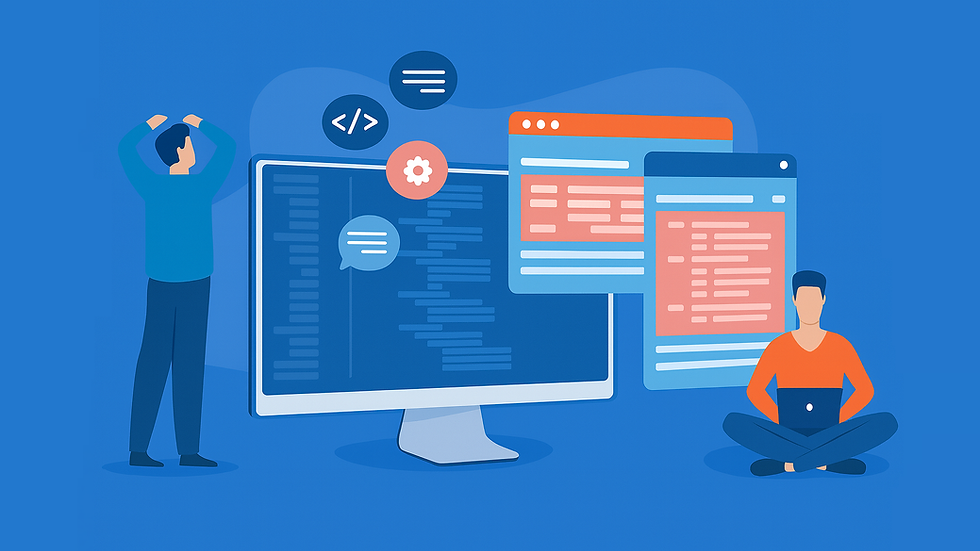- Ron Huber

- Sep 12, 2022
- 5 min read
Updated: Jul 31

There are some comparisons that are so iconic that they’re bound to sprak a debate when you bring it up, like which format for music is better: Vinyl or digital?
While there are some die-hard fans out there that swear music sounds better on vinly, digital music has made it easy for people to access their favorite songs and artists instantly without ever visiting a record store, buying a turntable, or cleaning the album.
The debate isn’t so much about which is better—they both play high-quality music. It’s more about the old way versus the new? And a similar argument exists today between developer portals and API portals.
Developers claim dev portals give internal teams everything they need, and they don't need all the new additional fluff API portals have. Meanwhile, API portal users claim its easy-to-use design and stack of built-in features encourage collaboration across multiple teams.
With digital transformation knocking on every business’s door, the need for a portal solution to maximize your digital assets is in more demand than ever. Only one portal has adapted to the changing landscape, while the other is stuck in the old ways.
Let's dive right in…
API Portals Are The Future
The future is here, and it's filled with no code. While this might start a riot in the community, we're here to tell you that dev portals, like vinyl records, are going out of style.
Why? Aren't dev portals the go-to for managing and organizing your APIs? Eh, well, that's another debate we'll get to in a minute.
The main problem with them is that developers have been their only audience—and that's a problem. The technological landscape is evolving, and the days of developers exclusively controlling development are numbered.
Don't get us wrong, developers are an integral part of software development and always will be in some way or another.
But with the rise of citizen developers and alternative low-code or no-code options becoming more available, dev portals just simply aren't able to meet the demands of this new crowd.
Businesses are realizing the potential of true digital transformation and collaboration is the name of the game—forever shifting the role of IT. Gone are the old days of teams working in silos and dev portals being their only way to collaborate internally.
Dev portals were the only tool available for many years, but thats’s not the case today.
API portals are designed for users of all technical backgrounds and have a slew of built-in features that users might need—giving them a clear advantage in this new environment.
With an outside-in approach to API management, API portals focus on making things easier for consumers, transforming how companies deliver their products.
So while the dev portal laid the foundation for what users should expect from an asset management solution, API portals adapted it to a version that's useable by a wider audience.
As these non-technical individuals continue to be involved in the development process, API portals will become more and more of a necessity and dev portals will become a relic of the past.
Accessibility and Management Matter…and Dev Portals Are Limited
Dev portals thrived in an environment where developers were the ones who needed and used them. But as businesses began their digital transformation journeys (en masse), they discovered a major problem—there are simply not enough developers to go around.
Despite citizen developers rising to fill this void, they lacked a shared solution that multiple teams could access. Enter API portals.
These digital storefronts act as a one-stop shop for all your API management needs. Do you want to market or educate your API assets to a larger audience? Or maybe you want to set up some self-service options for those technical users who know what to do.
You can do it all in one location with an API portal.
It's like searching for your favorite music on a digital music service. All you have to do is type a keyword into the search bar and a whole list of titles/artists populate. You can click on one and you can instantly enjoy your music anywhere.
You're probably starting to realize API portals are much more accessible than traditional dev portals. But let's go back to that argument: Aren't dev portals the go-to for managing and organizing your APIs?
Not any more.
If an API portal is like a digital music streaming service, then a dev portal is like an old fashioned record store.
It’s up to you to thumb through all the records to find what you need. Once you have it, you’ll have to bring it home, clean it, get your turntable out, and set the needle in the right spot to hear the song you want.
On top of that, dev portals only have a limited feature set that hasn't evolved to keep up with the changing environment. They lack granular access control, SSO, CI/CD integration, built-in productization, advanced search, collaboration tools and other features that businesses need to successfully manage their digital assets.
While these portals started out as the go-to management solution, they are quickly getting replaced with user-friendly and more advanced API portals. And those who want to maintain the “business as usual mindset” struggle to keep up.
API Portals Maximize Your APIs Potential
Now that we're bringing you over to the dark side, let's talk about the main driving force behind API portals' success. Hint: it's more than just good design and simple workflows. It's their built-in productization tools.
Bad news for those dev portal fans—the available productization tools are limited or non-existent. While they do let you create API products and share them, that's about the extent of their tools.
This is why others that talk about dev portals always warn you of "if you build it, they will come" syndrome. There's nothing that helps you monitor or market your API products once they're in your dev portal.
API portals, on the other hand, come equipped with a range of tools to increase adoption rates and track the success of your API products. The portal has a focus on the needs of a product owner and allows for: multiple publishing permissions, access management for private and public API Products and advanced taxonomy options for better UX. Plus, they let you tailor products to meet the needs of different audiences, making it even easier for users to discover and consume.
Even if you weren't convinced that an API portal is more attractive than a dev portal, you'd have to admit it's easier to sell products with a simple storefront accessible to a wider audience.
That's because the easier you make it for a consumer to find what they're looking for and the more attractive you make your product look, the more likely they are to actually purchase your product.
Whether your team decides to build their own API portal or use an out-of-the-box solution like Apiboost, you're guaranteed to have an API management solution that grows with your business.
Still have questions? We'd love to help you out. Let's chat.








